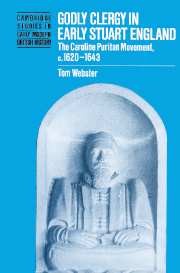Book contents
- Frontmatter
- Contents
- Acknowledgments
- List of abbreviations
- Introduction
- Part I Society, clerical conference and the Church of England
- 1 Clerical education and the household seminary
- 2 Profitable conferences and the settlement of godly ministers
- 3 Fasting and prayer
- 4 Clerical associations and the Church of England
- Part II The godly ministry: piety and practice
- Part III ‘These uncomfortable times’: conformity and the godly ministers 1628–1638
- Part IV ‘These Dangerous Times’: the Puritan Diaspora 1631–1643
- Index
- Cambridge Studies in Early Modern History
4 - Clerical associations and the Church of England
Published online by Cambridge University Press: 04 November 2009
- Frontmatter
- Contents
- Acknowledgments
- List of abbreviations
- Introduction
- Part I Society, clerical conference and the Church of England
- 1 Clerical education and the household seminary
- 2 Profitable conferences and the settlement of godly ministers
- 3 Fasting and prayer
- 4 Clerical associations and the Church of England
- Part II The godly ministry: piety and practice
- Part III ‘These uncomfortable times’: conformity and the godly ministers 1628–1638
- Part IV ‘These Dangerous Times’: the Puritan Diaspora 1631–1643
- Index
- Cambridge Studies in Early Modern History
Summary
We have suggested that the forms of clerical association discussed in the preceding chapters seem to have been given an extra degree of activism in the mid-1620s. At this point, this claim must be substantiated further and we must turn to the causes of this increased sociability. We must consider what the circumstances were that produced Thomas Hooker's conference in Essex and the Feoffees for Impropriations and, more importantly, what these activities mean. What is the relation of these rituals of sociability and the schemes they promoted to the Church of England in the early seventeenth century? Are we to see them as inherently subversive, as the product of a Puritan movement by definition at odds with the clerical establishment, or as activities merely adding to the public life of the church, a voluntarism which supplements without undermining?
Thomas Hooker's conference and the Feoffees for Impropriations represented a formalisation of ad hoc arrangements and practices present from early in the century, to go back no further. That formalisation took place early in 1626. In Essex and the south-east, the last months of 1625, indeed the time from Charles' accession to the throne in March, had been characterised by a heightened fear of Popish plots and concern among those best informed about church matters, regarding the inroads made by anti-Calvinists at the political centre. Francis Barrington, who played host to the fast in December, wrote to Lord Conway reporting ‘a rumour in this County of the great Concourse of people to papests houses both hear & adiacent counties’, hoping thereby to be a means by which ‘the recusants and papists may be disarmed’.
- Type
- Chapter
- Information
- Godly Clergy in Early Stuart EnglandThe Caroline Puritan Movement, c.1620–1643, pp. 75 - 92Publisher: Cambridge University PressPrint publication year: 1997



